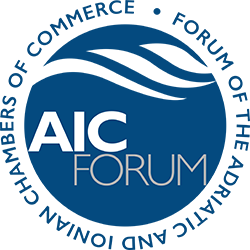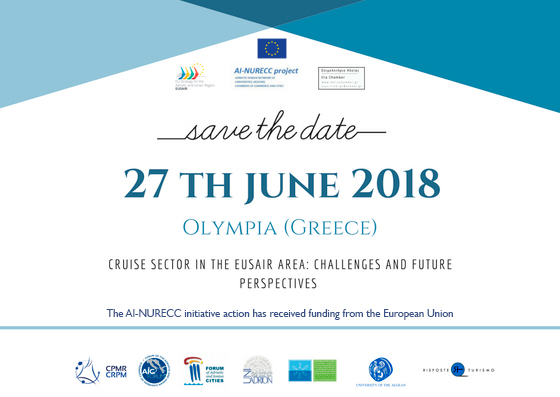On 27th June 2018, in Olympia (Greece), in the framework of AI-NURECC initiative, the event entitled “Cruise sector in the EUSAIR Area: challenges and future perspectives” was held, organized by the AIC Forum. The initiative, which took place at the SPAP Olympia Conference and Exhibition Center, was organized in collaboration with the Chamber of Commerce of Ilia – member of the AIC Forum – and the Region of Western Greece, and with the scientific support of University of the Aegean and Risposte Turismo.
The event was attended by more than 80 professionals, including guests and speakers from Italy, Croatia, Montenegro, Greece, Albania, Slovenia, Cyprus and Romania, as well as participants from Brussels and Istanbul and representatives of the European Institutions, for a day entirely dedicated to discussion and dialogue on the theme of the cruise sector and accompanied by a final workshop.
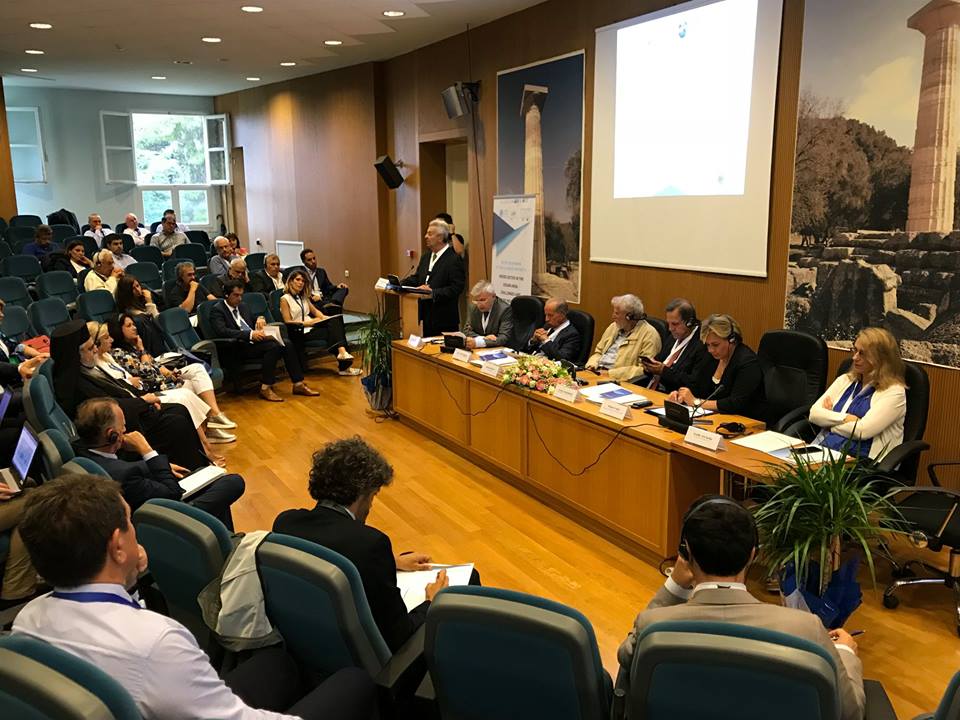
Wecome remarks opened by the President of the Ilia Chamber of Commerce, Nikoloutsos.
WELCOME REMARKS
The day started with the greetings, moderated by the President of the Ilia Chamber of Commerce, Konstantinos Nikoloutsos, by the authorities, such as the vice-mayor of Olympia, Giorgos Deves, and the Deputy Regional Governor, George Georgiopoulos, of the Region of Western Greece. Also present was the Director of “Eforate of Antiquites of Ilia”, Iris Kollia.
Among the guests also the Amb. Fabio Pigliapoco, Senior Advisor of the Adriatic and Ionian Initiative, who highlighted the importance of the AI-NURECC Initiative, that contributes to the implementation of the EUSAIR Strategy. The same Ambassador wanted to underline the importance of subsidiarity in strategies, as well as to remember that with the Declaration of Catania, adopted by the political authorities of the eight EUSAIR countries on 24th May 2018, the representation of the Ministers of the eight countries accepted that the former Yugoslav Republic of Macedonia becomes the ninth state participating in the Adriatic-Ionian Initiative.
Ambassador Bratislav Đorđević expressed his maximum interest, as Executive Manager, in charge of Tourism, of the Permanent International Secretariat of the Organization of the Black Sea Economic Cooperation (BSEC PERMIS), on the issue of cruise tourism. Aware of the fact that cruise industry is one of the most dynamic segments in the tourism sector, having enjoyed steady growth over a period of 30 years, Amb. Đorđević hopes that this trend will also involve the Black Sea region where cruise tourism does not yet follow this encouraging pattern (only 1% of the total number of world cruises takes place in the Black Sea). This is why it was proposed to organize, together with the UNWTO and the Ministry of Culture and Tourism of Turkey, an international conference to attract cruise tourism in the Black Sea and the Eastern Mediterranean, in Istanbul, at beginning of 2019. The Ambassador wanted to inform the participants that this initiative was also supported by the recent Meeting of the Ministers in charge of Tourism of the BSEC Member States, held in Varna, Bulgaria, on 14th June 2018.

The President of AIC Forum, Mirjana Cagalj.
At the end of the welcome remarks, the President of the AIC Forum, Mirjana Čagalj, presented the AI-NURECC Initiative highlighting the role of the AIC Forum and the upcoming activities, including the important 1st edition of the Joint Conference of the three Fora (Chambers of Commerce, City and Universities) which will take place in Split from 16th to 18th October. The plenary session of 17th October will focus on two main panels: “People on the Move” is dealing in particular with the current and important topic of migration, seen as source of challenges and opportunities, while the second, “Region on the move”, will focus on the possibilities and trends within the Region in various sectors, such as finance, transport and tourism. Particular attention will be devoted to digitization. Furthermore, on that occasion, the signing ceremony of the Memorandum of Understanding between the AIC Forum and the Association of Chambers of Commerce of the Danube will take place.
Finally, the President invited the people present to take actively part in this current event, since the results and feedback of this workshop will produce recommendations to be sent to EU Commission and to be used in subsequent events throughout the project contributing to future collaboration and planning of the relevant policies and sectors.
FIRST SESSION: THE ADRIATIC AND IONIAN SCENE – Cruise geography and traffic flows.

The speakers of the first session, starting from the left: Andrea Mosconi, Bojan Babić, Anthony La Salandra (moderator), Theodora Riga, Leonidas Varouxis and Maja Danilović.
The first round table of the plenary session was dedicated to cruise flows in the Adriatic Ionian area and analyzed some macro-trends that see the cruise sector growing at a pace that does not always correspond to that of the destination territories. In this sense, the Macro-region and the EUSAIR strategy can play an important role in the choices concerning the sector, also considering the fact that it concerns one of the few areas in which the “Adriatic” brand has established itself.
The works, moderated and introduced by Anthony La Salandra, Director of Risposte Turismo, saw the intervention of Andrea Mosconi, from the Chamber of Commerce of Ancona and representative of the AIC Forum, who provided the basis for discussion among those present at the Round Table: Theodora Riga, Director – Cooperation with other associations and Board of Directors Member, MedCruise; Bojan Babič, Director of the Cruise Terminal, of the Port of Koper; Maja Danilović, Marketing manager, of the Port of Kotor, and Leonidas Varouxis, President of the Municipal Harbor Fund of Katakolon.
According to the analysis of Mosconi, the growth in the demand for cruise tourism in the world does not know interruptions and, according to forecasts, the number of tourists will rise to 27.2 million in 2018. The Mediterranean, on the contrary, has been facing a phase of stability, after reaching a maximum number of visits in 2013; in 2017 overall movements in Mediterranean ports fell by 4%. The Adriatic area has a weight of just over 20% of the entire Mediterranean movement and in 2017 there were 4.7 million passengers, 1.4% less than the previous year. Looking at the data over a longer period of time, the Adriatic-Ionian ports have nevertheless increased compared to 4.2 million passengers in 2010, with an overall increase of 11.2%.
The area is very clearly influenced by the presence of a destination known worldwide as Venice, which weighs on the need to preserve a natural and artistic heritage of extreme fragility. The choices of tourists, however, are concentrated on a few destinations (in addition to Venice also Dubrovnik, Corfù and Kotor), leaving for the moment little space to other airports. The business model of the Adriatic-Ionian ports, in fact, is very heterogeneous and affects both the traffic dynamics on ferries and the commercial exchanges of solid and liquid goods, with organizational needs that sometimes clash with the most effective choices for the cruise segment.

Theodora Riga, Member of the Board of Directors, MedCruise.
The discussion, followed by the presentation of the data, was characterized by an analysis of the factors that could affect the growth of the sector in the next few years. “We need adequate infrastructure and many less specialized ports are moving in this direction”, as pointed out by Bojan Babic of the Koper Port Authority. Accoarding to Theodora Riga of MedCruise we must always remember that the cruise is for the tourist first of all an experience from which to return home happy and it is precisely on this factor that it is necessary to work, the product is sold by itself.
It has been stressed in several speeches, especially from Maja Danilovic (Port of Kotor) and Leonidas Varouxis (Port of Katakolon), that there are objective limits to the expansion of the offer that cannot be eliminated unless aiming at diversification and to de-seasonalization. For this reason it is necessary to work not only on the infrastructures but also on the organization, both in the port area but also in terms of tourist accommodation, and therefore on the synergy with local actors.
SECOND SESSION: EUROPEAN STRATEGIES FOR SUSTAINABLE CRUISE DEVELOPMENT – Funding tools and capitalisation on existing projects/best practices.
Eva Stefanidaki, ReShip – University of the Aegean, has introduced and moderated the second session – dedicated to the strategies for the sustainable development of the cruise sector and to the financing instruments, which opened with the intervention of Marco Zecchinato of the Joint Secretariat of the Managing authority of the Interreg Adrion Program. Dr. Zecchinato underscored the importance of enhancing the natural and cultural heritage as a growth activity in the ADRION air: with 34 approved projects and 47 partners involved in the first call, in the second call it was decided to take the cruise sector, which initially it was not included as a specific topic and specifically encouraged projects in this area, focusing on the evaluation of the transnational effects of rapidly growing segments such as cruise tourism and examining the interconnections between port facilities, ports and other maritime industries and matters relating to competition between land and maritime users in the coastal environment.

The EUSAIR Pillar IV Coordinator, Blanka Belošević.
It was then the turn of Blanka Belošević, Head Department for International Cooperation of Minister of Tourism in Croatia, and Coordinator of the Thematic Steering Group of the IV Pillar EUSAIR “Sustainable Tourism”, which intervened illustrating the priorities of action of the TSG in the field of tourism in the Adriatic-Ionic area with a particular focus on strategies for sustainable development of the cruise industry, focusing on which are the instruments of financing and capitalization of existing projects and “best practices”. The spokeswoman has underlined that there is not yet a specific reference to cruise tourism, in any case supported by EUSAIR, but this inevitably becomes of interest for Pillar IV, going to place in the development of sustainable tourism in the area.
Taking into account the specific objectives, the priorities of Pillar IV EUSAIR can be summarized in the diversification of the tourism offer – that is the products and services related to the cruise, naval and yacht sectors – and in the sustainability and responsible management of tourism.
According to Belošević, while it is true that the strategy without a source of funding is difficult to implement, it is necessary to take note of the existing opportunities among which AI-NURECC is one of the most important, thanks in particular to the fruitful collaboration between the Adriatic-Ionian Initiative and the partners of the same network (CPMR, Adriatic-Ionian Euroregion, Fora of civil society). Furthermore, it is equally important to underline the cooperation with the European Council as well as other synergies that can be created with other macro-regional strategies.
“It would be very useful to align transnational programs (priorities, criteria, evaluation) with macro-regional strategies, provide specific budget lines for projects of macro-regional strategies, take more action to achieve more effective cooperation between the four pillars, increase visibility and increase inclusion by all stakeholders, once the stakeholder platform is finished and operational“notes the rapporteur.

The EUSAIR Pillar I Coordinator, Sofia Loukmidou.
Sofia Loukmidou, Coordinator of the EUSAIR Pillar I “Blue Growth”, focused on what are the challenges and future prospects of the cruise sector in the EUSAIR area. After a brief introduction on the pillar priorities, the rapporteur focused on the strategies for developing sectors with high potential, such as aquaculture, coastal tourism, marine biotechnology, ocean energy, mining of the seabed, shipbuilding and ship repair, transport (goods and ferries), fishing, offshore oil & gas; and then focusing on what are the implementation activities in Greece: the Thematic Working Group (TWG) at the national level, screening sources for possible funding, the establishment of an inventory of databases; also providing examples of approved projects and providing suggestions on potential project proposals to implement.
Nikolas Tsipiras, Treasurer of INSULEUR, member of the Board of the Zakynthos Chamber of Commerce and member of the AIC Forum, underlines how also the new presidency continues to believe in the importance of collaboration with the Adriatic-Ionian Macroregion. Coastal and maritime tourism, which includes cruise tourism, is a key sector for the economy of many coastal and island regions in Europe. Following a public hearing organized by the Network of Insular Chambers of the EU (INSULEUR) within the European Economic and Social Committee (EESC) in Brussels in May 2014, on the basis of the Commission Communication “A European strategy for maritime and coastal tourism “, INSULEUR organized a Forum on” Impacts of cruise economy in coastal and island (and river) destinations” in May 2015 – in Olympia, during which the possibilities and conditions presented were explored for coastal, island and river destinations for businesses, examining the methods, means and procedures for the effective participation of island and coastal companies to promote this sector and to propose new products and services. Thanks to a review of the best international practices, current tools, training, etc., these results, over the course of time, are helping the Chambers and other local agencies and existing or potential companies to meet the modern industry needs and take advantage of it. “The most important thing to consider is the protection of the environment” observes Mr. Tsipiras. “Of course the funds are necessary and INSULER can play a very important role in financing funds for incentives to destinations, port infrastructure and business upgrades“. The speaker says he is confident that continuing this kind of collaboration can bring added value and resources.
The best practices of the “Routes of the Olive Tree” was presented by Miriana Katsilieri. Certified by the Council of Europe in 2005, this cultural itinerary represents – together with the Routes of the Roman Empire – the EUSAIR Area, and is part of the “Routes4U” project that was launched as part of the joint program between the Council of Europe (Directorate-General for Democracy – EPA on Cultural Routes) and the European Union (European Commission – DG REGIO). The project, which lasts 30 months (2017-20), is aimed at improving regional development in the Adriatic-Ionian, Alpine, Baltic and Danube regions. The project consists of itineraries of intercultural discovery and dialogue based on the theme of the olive tree. These routes are the gateway to a new cooperation between remote areas that would otherwise be isolated, since they bring together all the actors involved in the economic exploitation of the olive tree (artists, small producers and farmers, young entrepreneurs, etc.) threatened by the crisis.
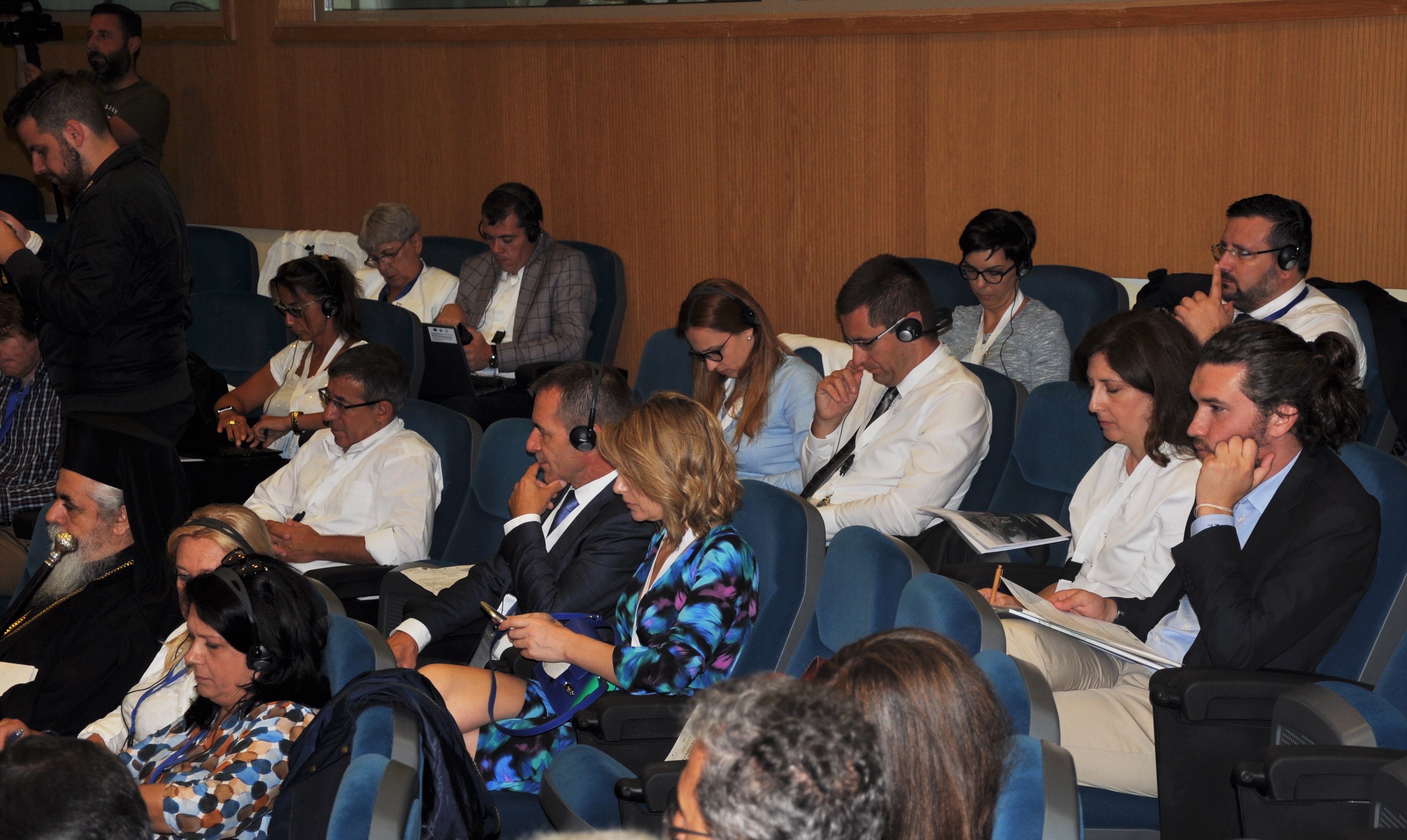 The session then saw the testimonies of some successful cooperation projects, including:
The session then saw the testimonies of some successful cooperation projects, including:
APPRODI, funded by Interreg ADRION and presented by Vaios Vaiopoulos, Ionian University of Corfu – Partner of the project, aims to strengthen the relationships between the cities involved, through a consolidated group of communities, and make a qualitative change, through a transnational approach, in the nature of tourist demand in the ADRION area.
SIROCCO, funded by the Interreg MED program, was presented by Marjan Dumanić, Rera S.D. – Project coordinator. The project, that has just come to the end, after 18 months of activity, focused on cruise tourism, aiming at exploring the economic, social, environmental and cultural impact and the potential of Mediterranean cruise tourism, as well as making recommendations for its sustainable development. In this regard, the speaker informs those present that they will be involved in the compilation of two questionnaires for the production of the project results and for the follow-up of the next activities.
BLUEMED, financed by Interreg MED and illustrated by prof. Yorgos Stephanedes, of the University of Patras, a member of UNIADRION and Partner of the project, deals with the creation of underwater museums and diving parks with the aim of increasing the attractiveness of coastal and maritime tourism through innovative, sustainable and “smart” tourism.
BEAT, financed by Interreg Italy – Croatia: capitalizing on the feasibility study implemented in the previous Blue Tech project, approved in the framework of Adriatic IPA cross-border cooperation 2007–2013, the partnership aims to create a cross-border cluster in the maritime sector and of shipbuilding including SMEs, universities/research centers and port authorities that strengthen the innovation processes of key economic players, such as qualified segments of shipbuilding and maritime sectors of “blue value chain”. Presenting this was Petra Karanikić from the University of Rijeka Technology Transfer Office, Project Partner.
The CAMPUSWORLD project represents a best practice of synergies between local actors, as it is financed by the Marche Polytechnic University, the Ancona Chamber of Commerce and the UBI BANCA Bank. Silvia Mangialardo, Head of the Office of the International Relations Office of Marche Polytechnic University, member and headquarter of the UNIADRION network secretariat, intervened presenting this project aimed at the internationalization of the student curricula, whose goal is to promote the integration of academic study and professional work experience. The rapporteur has put forward a couple of proposals to the closure of the intervention: the funding of some grants for placement in the cruise sector for students/young graduates from the EUSAIR area through the involvement of the Universities of the UniAdrion network. Public/private investors from the Adriatic-Ionian area could participate in the Campusworld budget for placement in the area and in specific fields. All this in order to offer new career opportunities, improve the knowledge of the foreign language, encourage internationalization and explore new economic realities, to offer a new service to companies and institutions and to contribute to the implementation of the EUSAIR Strategy.
BLUE CAREER CENTER, funded by EASME – Executive Agency for SMEs – was presented by Georgios Georgiou, Coordinator of the Eastern Mediterranean and Black Sea project. Blue Career Center aims to attract graduates or people with professional training and make them qualified for maritime professions through targeted and innovative actions. Among the expected results of the project is to establish the headquarters of the Secretariat of the Blue Career Center in Cyprus, with the representation of Greece, Bulgaria and Romania, and to organize the first Regional Conference on “Maritime Education and Training Providers”.

Speakers of the session dedicated to successful cooperation projects.
THIRD SESSION: DESTINATIONS’ RESPONSE TO CRUISE DEVELOPMENT CHALLENGES

Anthony La Salandra, Director of Risposte e Turismo, together with the President of Ilia Chamber of Commerce.
The works of the third session, moderated by Anthony La Salandra – Director of Risposte Turismo – saw in the first part the presentation of some case studies of the ports of the Adriatic Ionian area and of a challenger case study of the Black Sea area on river cruises for then, together with the speakers themselves, discuss issues related to the development of cruises in the last decade and the challenges that the port authorities together with the stakeholders of the area find themselves facing in order to better grasp the potential of the sector as a driver for sustainable tourism development.
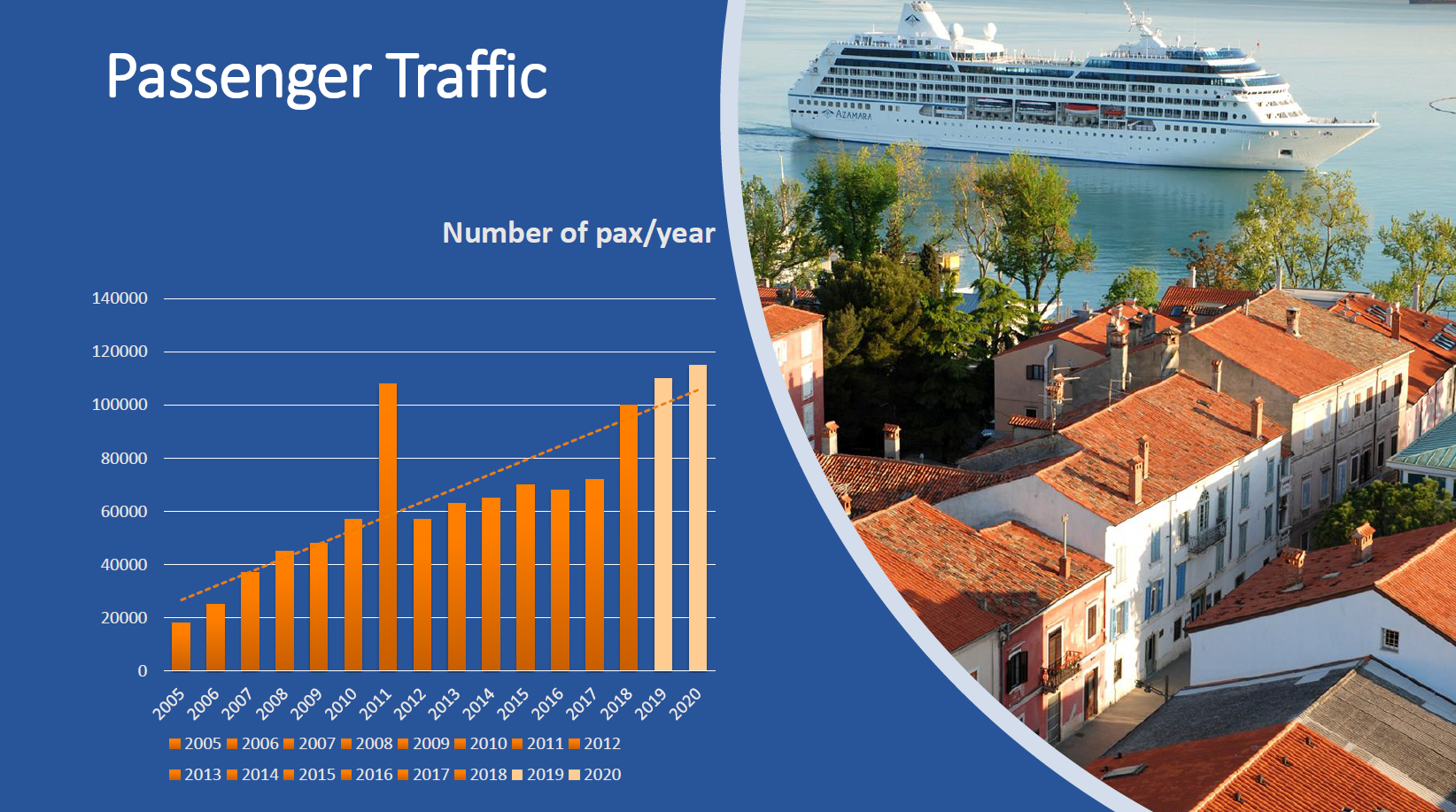
Number of passengers per year in the port of Koper.
Bojan Babič, director of the cruise terminal, port of Koper, showed that since 2005, the year in which the activities began, the trend in passenger growth has been strengthened from year to year (up to a million attendance). Nonetheless, the same Babič hopes for new collaborations, even if the infrastructure remains a problematic issue, shared with Ancona, which is similar to Koper in terms of both experience in the cruise sector – recently completed since 2005, and of development of tourist attractiveness. To present this case study, Giovanni Manzotti, Head of the Department of Economic Development of the Chamber of Commerce of Ancona and member of the “Welcome to Ancona” project. This initiative was born from the need to win the challenge of growing foreign tourism coming to Ancona thanks to the cruise industry. The collaboration between the various public and private bodies, including the Chamber of Commerce has been successful: the forecast for 2018 is 56,000 passengers / year. The “Welcome to Ancona” model is aimed not only to tourists but also to “transit passengers” (1 mln) who come and go from Greece, Croatia and Albania by ferry, thanks to an agreement with Port Authorities and maritime agencies. The goal is to increase the numbers but the infrastructure challenge to host large ships is not easy. Manzotti said that it was precisely the cooperation and investment compared to the cruise-phenomenon that led to consider the port as a point of attraction for the whole city, not only for tourists but also for citizens.
Therefore it becomes clear how the way of cruise tourism changes and meets new challenges, starting from infrastructural and cultural ones, and must strive to grow in harmony with opposing interests. According to Marko Miljanić, head of the Department of Tourism, Entrepreneurship and the Sea, of the city of Dubrovnik – as well as member of the FAIC, which presents an experience completely opposite to those of Koper and Ancona: Dubrovnik is indeed to handle the phenomenon of over-tourism, mainly due to the cruise sector, which risks damaging the artistic and cultural heritage of the city, a UNESCO heritage site. Miljanic stresses that the number of tourists has doubled in the period 2010-2017 and is expected to grow again. “Protecting and respecting heritage starts with us, political and business leaders, the locals and then the tourism industry and travelers. Only in this manner can it remain a base for sustainable welfare and an inspiration for all”. This is the reason why the locals started with “Respecting the city” in 2017, a responsible tourism project that involves all stakeholders, not only from turism.
In this sense, stakeholders awareness raising, involvement and participation is fundamental. They are working together to garantize better coordination and distribution of embarking & disembarking times for cruise passengers (CLIA) and they decided for 2018 for Monitoring and limiting the number of visitors at cultural heritage hotspots. The rapporteur also mentioned the ALTER ECO program, MED 2014-2020, a pilot activity involving the use of IT technology in order to divert tourists from the main road area (Stradun) to alternative city attractions in order to increase the flows in these places and lighten the overcrowding of the Old Town.
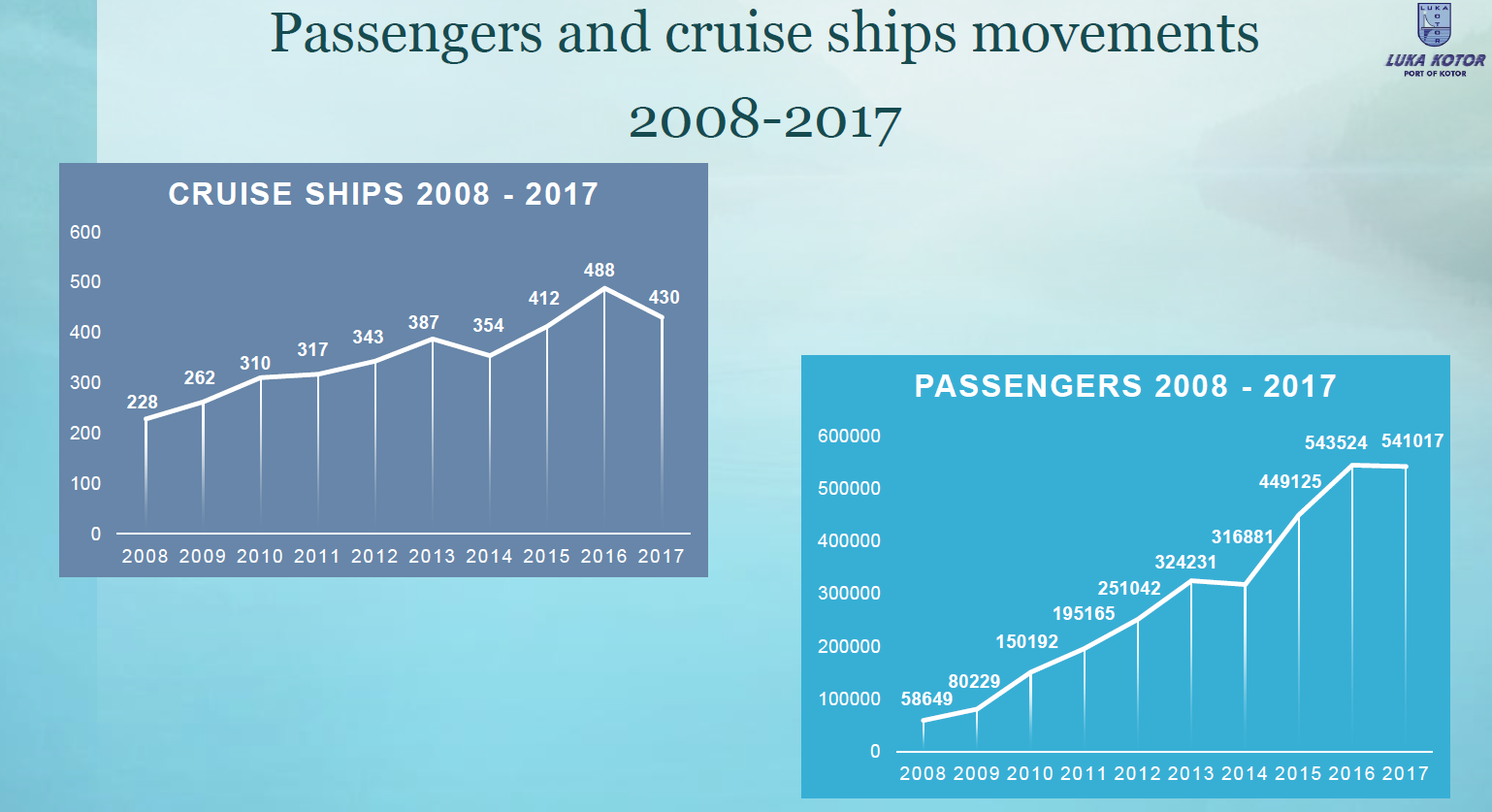
Trend of cruise ships and passengers’ presence in the port of Kotor.
When it was asked him about the challenges to be faced with the cruise industry, according to Miljanic, each port is different, but often management problems can be solved with similar solutions and, in this perspective, collaboration between the various local stakeholders is crucial.
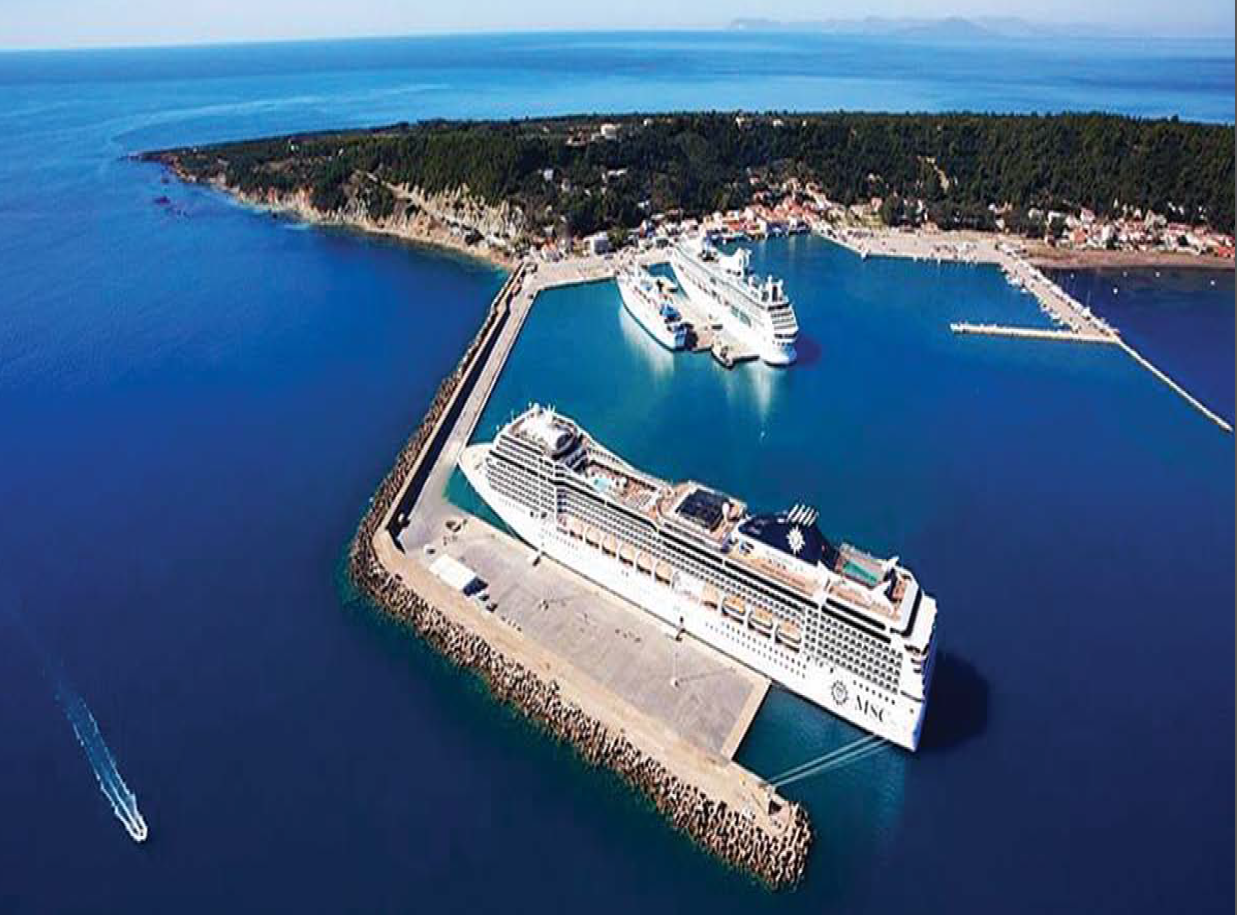
Port of Katakolon, “case study” presented by Leonidas Varouxis.
Leonidas Varouxis, president of the municipal port fund of Katakolon, explained how, in the last 25 years, the small local port has become the second largest cruise port in Greece and one of the most important in the Mediterranean. Katakolon is indeed the gateway to the land of the Olympics, UNESCO heritage.
To close the session, the testimony – as “challenger case study” – by Valentin Moldoveanu, county councilor of the Tulcea County Council – Romania, member of the CPMR, which, illustrating a different type of cruise tourism, that on the big rivers, has showed as the number of cruise ships arriving in the Danube Delta has almost doubled over the last ten years. This phenomenon has been explained by tour operators as an increase in the perception of the security of the area given by Romania as an EU member and of NATO as well as a different strategic approach, by some international companies, which is moving towards river crocierism instead of on the Black Sea.
LAST SESSION: WORKSHOPS, RESULTS AND CONCLUSIONS.
At the end of the round table, speakers and participants were involved in a workshop, organized in collaboration with the Research Laboratory in “Shipping and Port Management (ReShiP), Department of Shipping, Trade and Transport” of the University of the Aegean. The aim of the workshop was to identify the contemporary challenges that EUSAIR cruise destinations face and provide common solutions to the way and the means necessary to overcome the problems (operational and managerial) in order to guarantee the sustainable character of the development of the cruise in the wider area. Participants, after having been divided into groups, took place around tables and, through a method called “art of hosting”, based on the self-organization capacity of the groups, they were invited to participate in strategic conversations as drivers for the development and change. The workshop, led by Eva Stefanidaki, was the right conclusion to move on a plan of dialogued practice as assimilated following a day in which many ideas and reflections were shared. The results of the workshop have been translated into recommendations to be presented to DG Regio and will be used on the occasion of future AI-NURECC activities.
The day ended with a guided tour, organized by the hosting Chamber of Ilia, in the archaeological site of Ancient Olympia, UNESCO heritage since 1989.

Eva Stefanidaki conducted the Workshop, organized in collaboration with ReShiP of the University of the Aegean, concluding the day.
Presentations:
Andrea Mosconi – Ancona Chamber of Commerce
Blanka Belosevic – Coordinator Pillar Sustainable Tourism
Sofia Loukmidou – Coordinator Pillar Blue Growth
Silvia Mangialardo – Campusworld
Georgios Georgiou – Blue Career Centre
